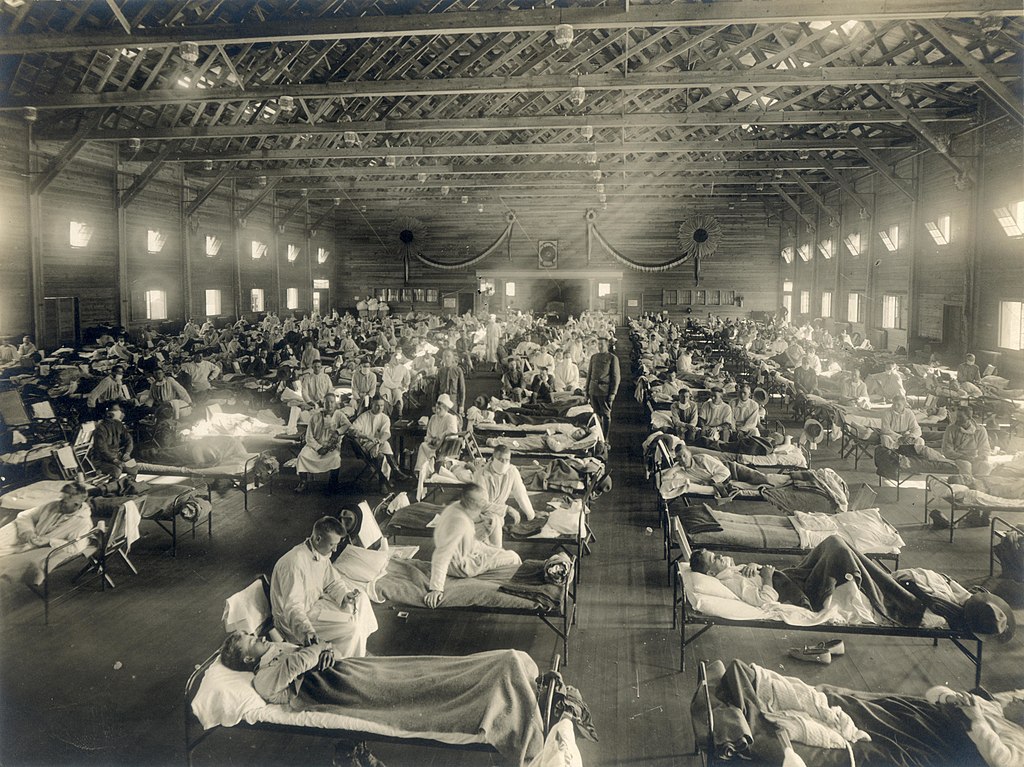The "Spanish" Flu Pandemic of 1918-1920
Written by Pam Preedy.
Towards the end of January in 1918, Dr. Loring Miner who lived in Haskell County, Kansas was called to see a patient with body aches, fever, a headache, and a dry cough. It was clearly influenza, but the symptoms were more severe than typical flu symptoms, and as the days went on more people became ill, with disproportionately large numbers of young, strong adults dying.
Then it spread to a military training camp, Camp Funston in Kansas, on March 4, 1918. Private Albert Gitchell was a cook handling lots of food that would be delivered across the camp. Gitchell had an extremely high fever, (103F), sore throat, and he “ached all over”. He was quickly followed by others with men registering temperatures of 103-107F.
As many as 500 men ended up in the infirmary that week. two weeks later, 1,100 men required hospitalisation with thousands more sick in the barracks. Dr. Loring Miner put out a Public Health warning – nothing was done. Within a month, the Flu seemed to be over as a number of patients began to decline.

Camp Funston was the training camp for the American forces preparing to embark for Europe and the disease soon spread to other training camps and ports of embarkation. By April, 1918 the virus had reached the French posts and by the middle of the month had reached the Western Front. It then spread rapidly through Europe and quickly became global, reaching the far East and Australia via India.
Where did the "Spanish" Flu come from?
New evidence suggests a new source of the virus: China. Chinese labourers were required to work on the Western Front; digging trenches, unloading trains, laying tracks, building roads and repairing damaged tanks.
Some 90,000 Chinese labourers (mostly farm labourers) were transported across Canada to work in the Chinese Labour Corps on the Western Front. They spent six days in sealed containers crossing Canada and then on to France.
Some 3,000 ended their Canadian journey on medical quarantine. Their symptoms were not taken seriously, but blamed on the unfair racist prevalent view; “Chinese laziness”. By the time they reached France in early 1918, many were sick and soon hundreds were dying.


Britain and other protagonists had imposed laws of censorship on the media, but there were no such laws in neutral Spain. When King Alfonso 13th of Spain was taken gravely ill with flu, it hit the Spanish headlines. In Britain it was claimed that it was carried to Britain on the dry spring winds and therefore Spain must be to blame!
There were three waves of the flu. The First wave lasted from the beginning of 1918 and was relatively mild. Mortality rates were not appreiciably above normal; int he United STates 75,000 flu-related deaths were reported int eh frist six months of 1918, compared to 63,000 deaths during the same time period in 1915.
In Madrid, fewer than 1,000 died of it between May and June 1918. No quarantine was instituted. However, the first wave disrupted military operations of World War 1, with three-quarters of French troops, half the British forces, and over 900,000 German soldiers sick.
The second waves was a much more aggressive form attacking the sick and elderly. The virus could kill quickly; taken ill in the morning and dead by the evening. When post-mortems were done, it was found that a patient’s lungs were filled with fluid so that they had literally drowned, which is presumably why they turned blue.Certainly coronavirus has attacked the lungs and patients who became very sick need oxygen. The problem with diagnosing influenza is that there are a whole variety of symptoms.
Was it one disease or several diseases?
While medical knowledge at the time knew about bacteria, very little was known about viruses.
The third wave started in January 1919 and lingered until June that year. Some countries suffered a fourth wave until late 1920. There was little that could be done for the patients except to provide palliative care: to reduce the fever, hydration and bed rest. There were no flu vaccines, antiviral drugs, antibiotics or mechanical ventilators. Treatment tools were basic and limited to supportive care and unproven remedies.
Some old medicines were tried with greater or lesser success – as has been done during the latest pandemic.
The scientists were searching unsuccessfully for a vaccine. We are lucky that vaccines have been developed for our protection.

Its name was Enza
I opened the window
And in-flu-enza
(Children’s playground rhyme – 1918)
Further your research
For more information visit the Bromley Historic Collections on the 2nd floor of Bromley Central Library to learn more about Bromley Borough’s history.
Originally published in Life in Bromley magazine (Issue 9, November 2022)
